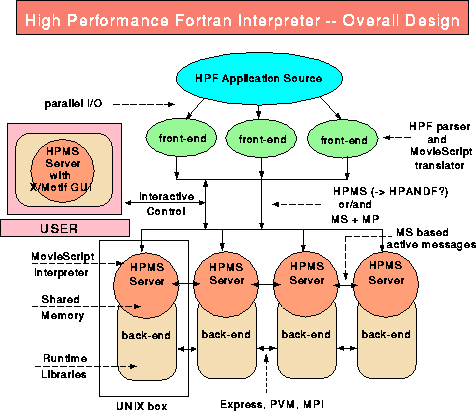HPF Interpreter (HPFI) is a HPSIN module developed at NPAC on top of core software technologies such as F90D compiler and MOVIE. The system follows a modular layered design which will allow to experiment with various front- and back-ends, developed by several R&D groups. In HPFI, the HPF source is translated first into the intermediate interpretative format given by MovieScript - a programming and communication language of the MOVIE system - and then interpreted by a mesh of MOVIE servers running on a network of workstations or a multicomputer. Dynamic features of the MOVIE system such as preemptive multithreading provide support the for interactive debugging, monitoring and rapid prototyping of HPF applications.

At the moment, the work on HPFI design is completed and the implementation work is in progress. The system includes three layers of parallel meshes: A) HPF front-end, B) intermediate interpretative form, and C) back-end. The layer A translates HPF source code into the intermediate form which is passed to and interpreted in layer B, using the runtime lib support provided by layer C. On a network of workstations, each layer is represented by a mesh of UNIX processes, with layers A and B communicating via intermediate script passing and with layers B and C communicating via shared memory.
This layered modular design admits several explicit implementations and allows to combine existing and forthcoming modules, developed by independent research teams. Intra-layer communication follows the message passing models (express,PVM.MPI) used by specific data parallel runtime libraries in layers C, whereas the internal layer B is based on fully asynchronous model, supporting active messages and multithreading, required for interactive debugging and monitoring.
In the present trial implementation, we use components of F90D compiler in layers A and C and the MOVIE system in layer B. Intermediate form is identified with the matrix algebra sector of MovieScript - a communication and computation protocol of the MOVIE system.
An HPF source is converted to MovieScript + message passing in layer A and passed to layer B which handles node array processing and to layer C which handles data parallel communication. An HPF task is mapped on a mesh of MOVIE threads, with one such thread per MOVIE server. Additional threads are spawned interactively in response to user requests, passed via Motif based GUI down to layer B. A mesh of synchronous HPF threads interprets the HPF source, whereas a (typically non-homogeneous) collection of auxiliary asynchronous threads is reacting to user (e.g. debugging) or system (e.g. load balancing) requests.
A proof-of-the-concept demo, illustrating the HPFI design described above, was presented at the Supercomputing'93.
We are also exploring ANDF (Architecture Neutral Distribution Format) by OSF, based on TDF protocol by RDA, U.K., and we are evaluating the idea of using MovieScript as a prototype for HPANDF, i.e. common intermediate form for compilers and interpreters of various HPLanguages.
-
Fox, G.C., and Furmanski, W.,
Towards Interpreted Run-Time Fortran90D Environment
NPAC Technical Report, 1992.
-
Fox, G.C., Furmanski, W., Hornberger, P., Niemiec, J., and Simoni, D.,
Towards Interactive HPCC: High Performance
Fortran Interpreter,
Handout Material for the HPFI Demo at the Supercomputing'93,
Portland, Oregon, Nov 15-19, 1993.
-
Johnson, A., Loveluck, J., and Goldstein, I.,
The ANDF Technology Program at the OSF RI,
OSF/RI Technical Report, Cambridge, MA and Grenoble, France, 1992.
- Peeling, N.E., ANDF Features and Benefits, DRA Technical Report, DRA Malvern, U.K., 1992.